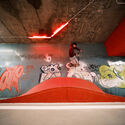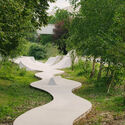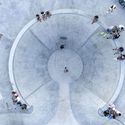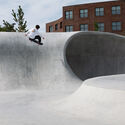
How is it possible to achieve emotional well-being in public spaces? What role do public spaces play in promoting urban well-being? Considering that sports practices can be a vital component in creating healthy public spaces, skateboarding, one of the most globally recognized urban activities, offers an alternative for building opportunities for the physical, recreational, social, cultural, and even professional development of multiple generations.
Through movement and motor games, human beings can experience new sensations and forms of stimulation. Through sports, physical education develops abilities such as spatial and space-time perception, hand-eye coordination, agility, balance, segmental control, and more, connecting with body language, as well as emotional, social, and cognitive dimensions. It also teaches people to assume roles within a group by taking on responsibilities, understanding established rules, and experiencing new emotions by overcoming challenges and accepting both success and failure. As outlined in the Global Action Plan on Physical Activity 2018–2030, physical activity is proven to contribute not only to improved health, quality of life, and well-being but also to reducing fossil fuel use, generating cleaner air, and enabling safer, less congested roads.

Connected to the urban environment, skate culture emerges from major cities. For example, Barcelona has been one of the most visited destinations for worldwide skaters since the early 2000s. According to Henri Léfèbvre, the city as a stage is “the place where society’s contradictions are always revealed.” While urban space production is indeed complex, it also involves a dialectic shaped by diverse interests and the appropriation of space by a variety of users, cultures, values, and practices. Whether as a mode of transport or a sport, skateboarding represents an informal appropriation of urban space. It is also a performance-oriented activity that draws attention and, when properly considered, can contribute to the revitalization and regeneration of urban spaces.
Related Article
Architecture and Public Spaces: 11 Skate Parks Around the World
In a broad debate that gathers multiple perspectives and opinions, some sectors of society categorize this activity as a form of urban destruction that damages public furniture and city pavements, endangers other users, or causes noise disturbances in urban life. Through fines, sanctions, or additional devices, authorities, organizations, institutions, and some citizens have banned this activity in certain areas. However, what happens to urban spaces that have become obsolete or abandoned, often encouraging crime and insecurity? How can skateboarding help renew or reactivate them with complementary uses to foster urban coexistence in harmony?

Several designers, landscape architects, architects, and urban planners make tireless efforts to integrate and revalue the socio-spatial contributions generated by skateboarding in public spaces, creating attractive areas suited to this type of activity and its potential users. For example, the Vltavská Undergroung underpass in Prague seeks to bring new life to a public space that residents had long avoided when passing through the Vltavská transport hub. By offering freestyle activity zones, a mirrored dance floor, a public art gallery, and other uses, the project proposes the creation of a safe shared space for skaters, pedestrians, and cyclists, enhanced with new linear lighting to reinforce the feeling of safety, a seating area overlooking the city, among other features.

As Xavi Camino explains in "Reinterpreting the City: Skater Culture and the Streets of Barcelona," skateboarding originated in a context of economic, social, and political prosperity, rooted in the development of welfare and consumer culture in the United States during the late 1950s. The practice emerged on the coast of California as an abstraction and transformation of surfing. When ocean conditions were not suitable, skateboards could be used in the city on concrete and asphalt to move through streets and buildings. In the early 1960s, skateboarding gained popularity among teenagers and youth in the U.S. and some Northern European countries. It gradually became independent from surfing, developing its own economic, social, and cultural field. However, the successive economic crises of the 1970s shifted the expectations built during those earlier years, and many companies in the sector were forced to close. Nevertheless, some groups of young people continued skating and developed a new cultural interpretation of the practice, making use of marginal or abandoned spaces that reflected the ruins of prior economic prosperity.

Since its inception, the shape of the skateboard, the way skateboarding is practiced, and the types of spaces where it takes place have evolved continuously, transforming from an underground activity into a global industry. In the late 1970s, the emergence of technical maneuvers deepened the use and meaning of urban furniture in cities, giving architecture and urban design new purposes and interpretations. Unlike other sports that operate within a regulated "field," skateboarding can be practiced anywhere with a hard surface. Skaters can interpret the urban environment in creative and unique ways. The Nike HomeCourt Skate Landscape project, for example, aims to provide a stimulating creative canvas that combines traditional architecture with skateboarding. It is conceived as a public space that incorporates elements compatible with the sport, based on the typologies that shaped it over the past decades, and capable of creating a new paradigm in architectural landscapes.

Although there are numerous fenced or separated skateparks, skate plazas, and enclosed facilities for skateboarding, many professionals in architecture and urban planning seek to integrate and explore different strategies to interweave this practice into cities. The Skatepark Av. Beira Mar in Brazil and the Stella Plage Skate Park in France are examples that propose its integration into the urban and landscape development of their respective settings, with designs that enable the free movement of users and, in some cases, coexistence with other uses. In fact, the Sports Complex in Sant Francesc Xavier by MCEA | Arquitectura promotes interaction among different age groups through various sports modalities. It includes areas for learning to skate aimed at younger users, street-style and bowl skate zones for intermediate age groups, and bio-healthy activity areas for older users. A common and winding path is designed to connect these zones and encourage interaction among all users.

Bringing together a diverse population, skateparks have become gathering places for children and adults alike, playgrounds for all types of wheeled sports, and professional training grounds for skateboarding. Building communities, they provide surfaces for tricks, challenges, and routines on smooth surfaces, often mimicking the concave shapes of ocean waves or incorporating urban elements like handrails, stairs, benches, and slopes. But while this is a practice born in the city, could it also be integrated into the domestic sphere or in unexpected places? On the islands of the Paraná River, across from the city of Rosario in Argentina, Skatehouse 2 by Macu Bulgubure includes a skate ramp in a family home, where the exterior deck turns into a ramp, becomes a south-facing wall, and ends in an overhang to block the high summer sun. Inhouse Brand Architects also transformed an unused lounge area of a Cape Town residence into an industrial-inspired living room with a concrete skate bowl playing a central role in the design. Similarly, in the context of adaptive reuse, Tim Greatrex’s House of Vans London project repurposed the historic railway arches, once home to the Old Vic Theatre, into a cultural center for skateboarding, art, film, and music.

In the pursuit of supporting the sustainable development of sport and leisure, the construction of these spaces must consider everything from user safety to maintenance and the natural aging of materials. While smooth surfaces should prevail, combining textures, colors, and materials provides a distinction that requires careful attention to joints and transitions to ensure safety and create seamless, clean surfaces. For example, La Duna Skatepark and Communal Center used high-tech concrete to achieve a smooth, continuous surface, selecting a color that integrates with the local sand that naturally surrounds the area.

Concrete offers great durability and weather resistance with minimal maintenance costs, whereas wood, though impact-absorbent and versatile, requires protection from climatic conditions. In Cañales Skatepark by Quintanilla Arquitectos in Mexico, materials were chosen to withstand local weather in their raw, unfinished state. By avoiding surface treatments and aiming to reduce long-term maintenance, the project also prioritized locally available materials. On the other hand, the construction of Skatepark Continua by MBL Architectes in France explores the expressive potential of wet concrete. As a performance in itself, the building process celebrated the project’s connection with its site: its fabrication being largely owed to the skill of the masons who shaped it. Metal structures were assembled and welded on-site, while fresh concrete was sprayed onto the framework and then stretched and smoothed into shape before setting. It's worth noting that although metal surfaces can allow for high speeds, they also come with many drawbacks: excessive heat from sun exposure, rust, pitting, and peeling sheets can compromise skater safety.

Recognizing the power of skate culture and the conception of its practice spaces can acquire in shaping urban life, architecture and urbanism face a challenge that involves dialogue between disciplines to create community spaces where skateboarding can interact with broad age groups. Aiming to promote more inclusive, sustainable cities that are responsive to the needs of their citizens, flexible design will help foster skaters’ creativity while also making room for complementary uses that benefit the entire community.

This article is part of the ArchDaily Topics: Building Wellbeing: Designing Spaces for Healing, presented in collaboration with the Hushoffice.
With its line of A-class pods Hushoffice helps create acoustically balanced workplaces that offer great environment for collaboration and focus, foster employee wellbeing, and accommodate the needs of neurodiverse staff, as well as employees with motor impairments.
Every month we explore a topic in-depth through articles, interviews, news, and architecture projects. We invite you to learn more about our ArchDaily Topics. And, as always, at ArchDaily we welcome the contributions of our readers; if you want to submit an article or project, contact us.


































